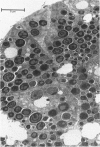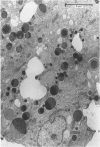Abstract
The effects of pharmacological and nervous stimuli on the flow of secretion from the dog lateral nasal gland following catheterization are described. Drugs were injected close-arterially into the arterial supply to the nose, or intravenously. Cholinergic agonists (pilocarpine, methacholine), given intravenously (I.V.) or intra-arterially (I.A.), and stimulation of the vidian nerve produced a copious flow of secretion which was blocked by atropine. The adrenoceptor agonists phenylephrine (alpha) and salbutamol (beta 2), given I.V. or I.A., and stimulation of the vagosympathetic nerve produced a small but consistent flow of secretion. Histamine (50 micrograms), substance P (0.1 micrograms) and prostaglandin E1 (1-5 micrograms), injected I.A., produced small flows of secretion. Bradykinin (25 ng-50 micrograms), 5-hydroxytryptamine (100 ng-50 micrograms) and vasoactive intestinal peptide (VIP) (10 ng-50 micrograms) did not cause secretion. The total protein content, the composition of secretions as revealed by sodium dodecyl sulphate-polyacrylamide agarose gel electrophoresis, and changes in [Na] and [K] in relation to flow of secretion are described. Differences in ion and protein concentrations, and in protein composition, are described for vidian nerve-induced and vagosympathetically induced secretions. Electron microscopy revealed that the gland contains serous cells in the secretory region, and ducts morphologically similar to the intercalated, striated and excretory ducts of salivary glands.
Full text
PDF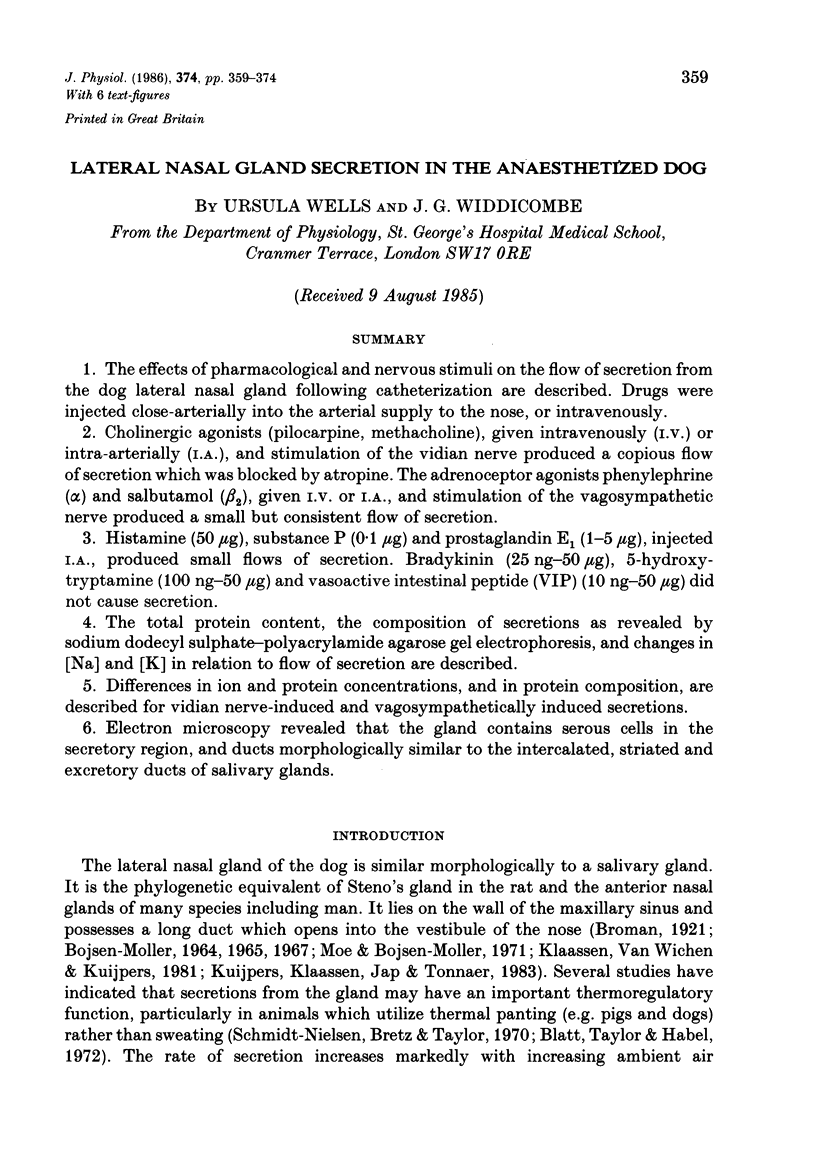
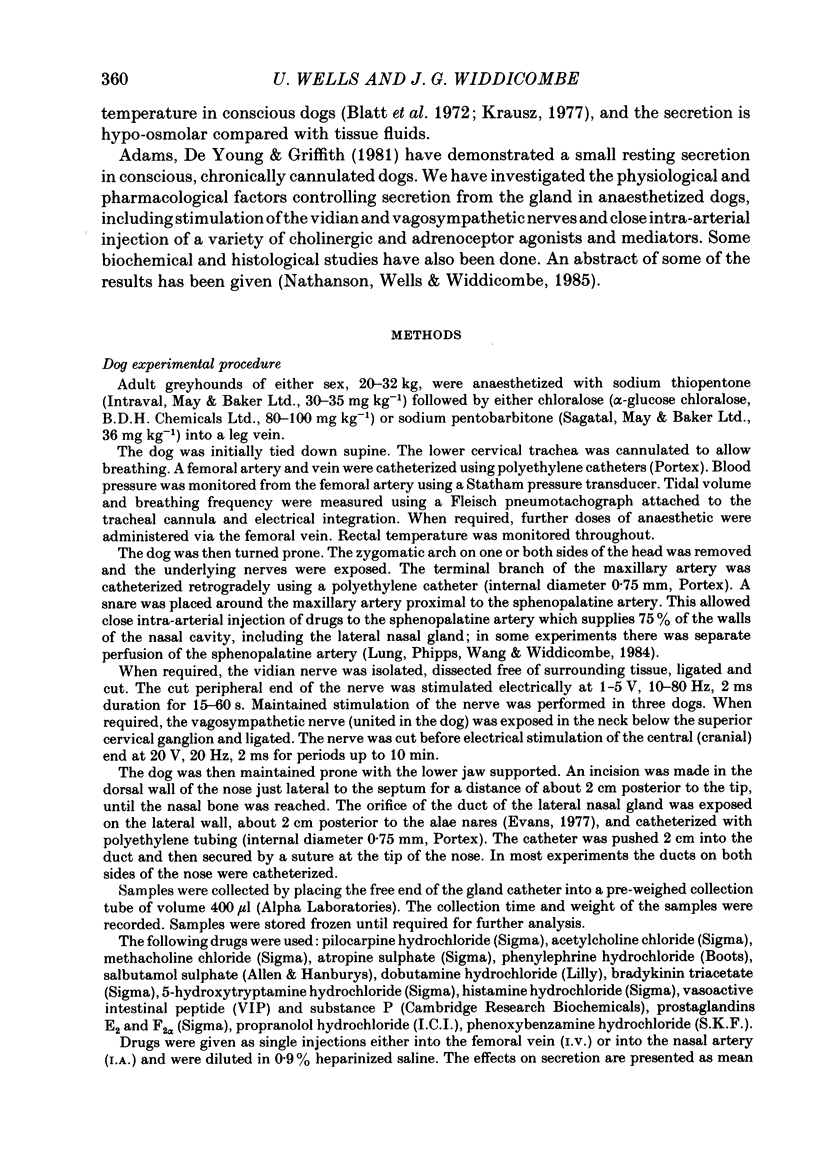
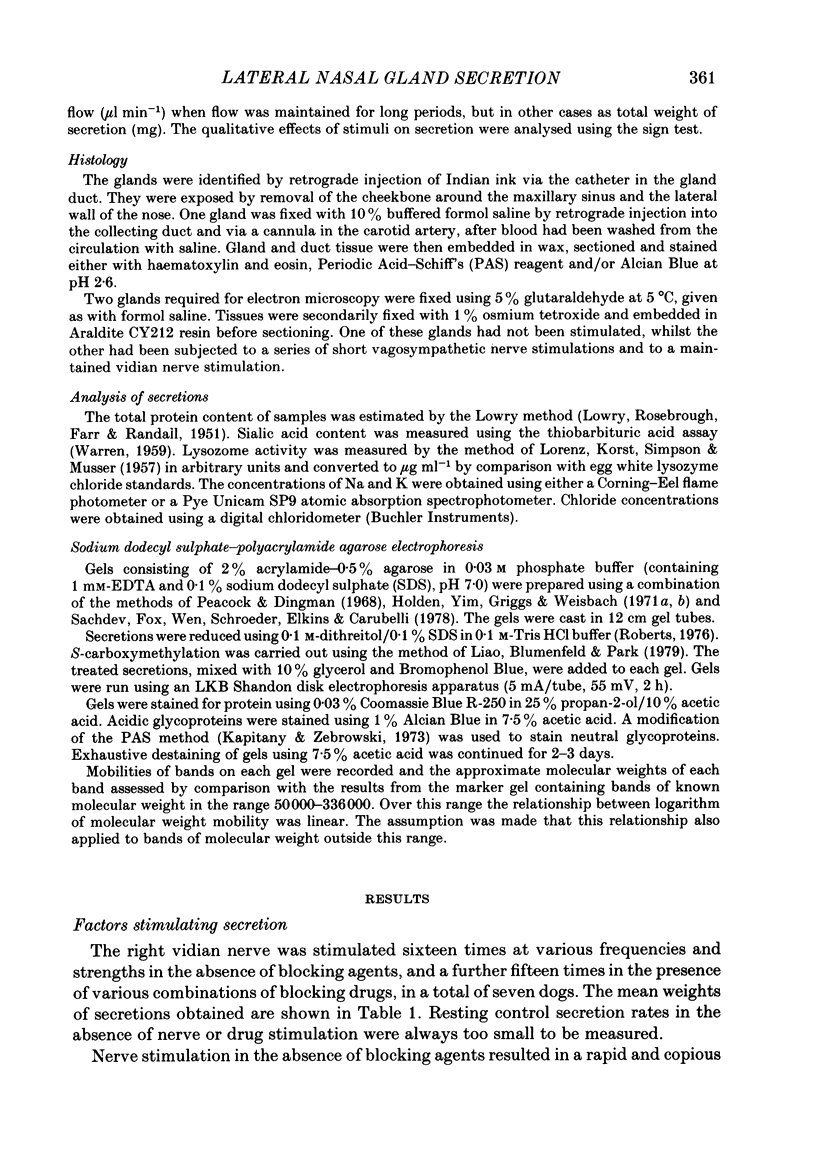
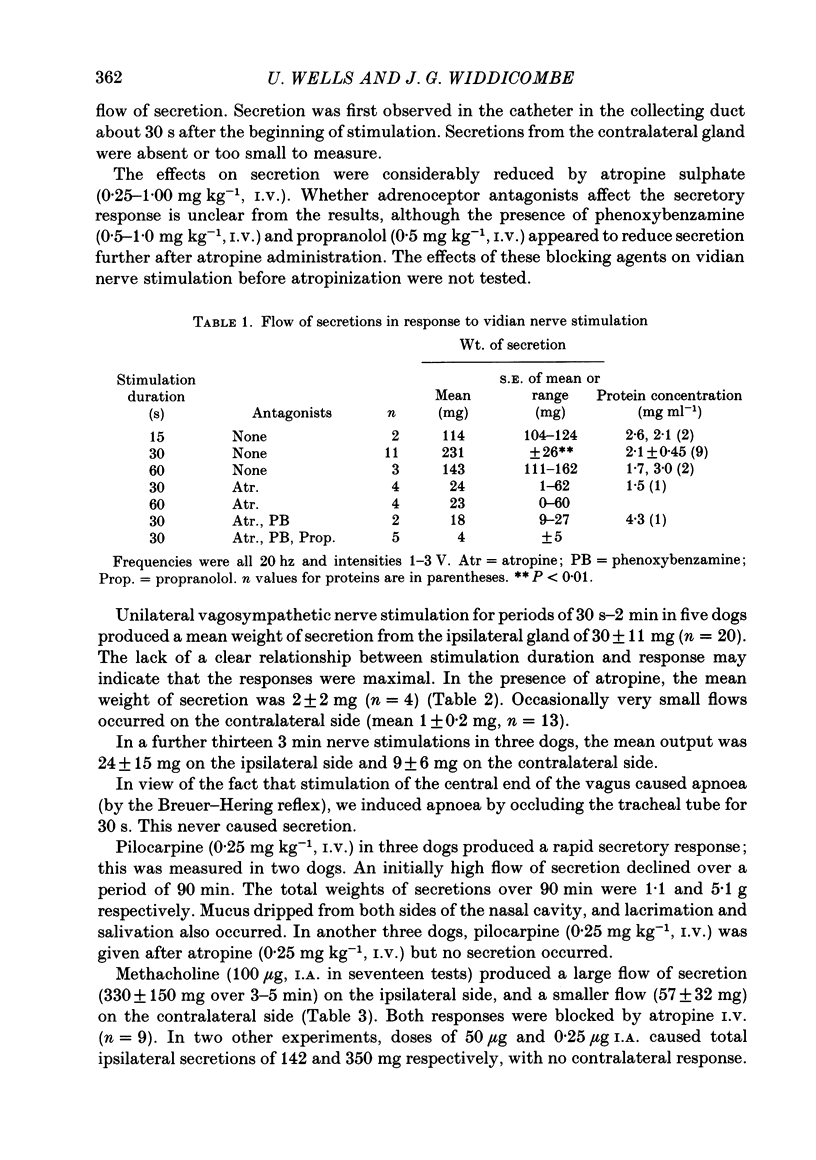
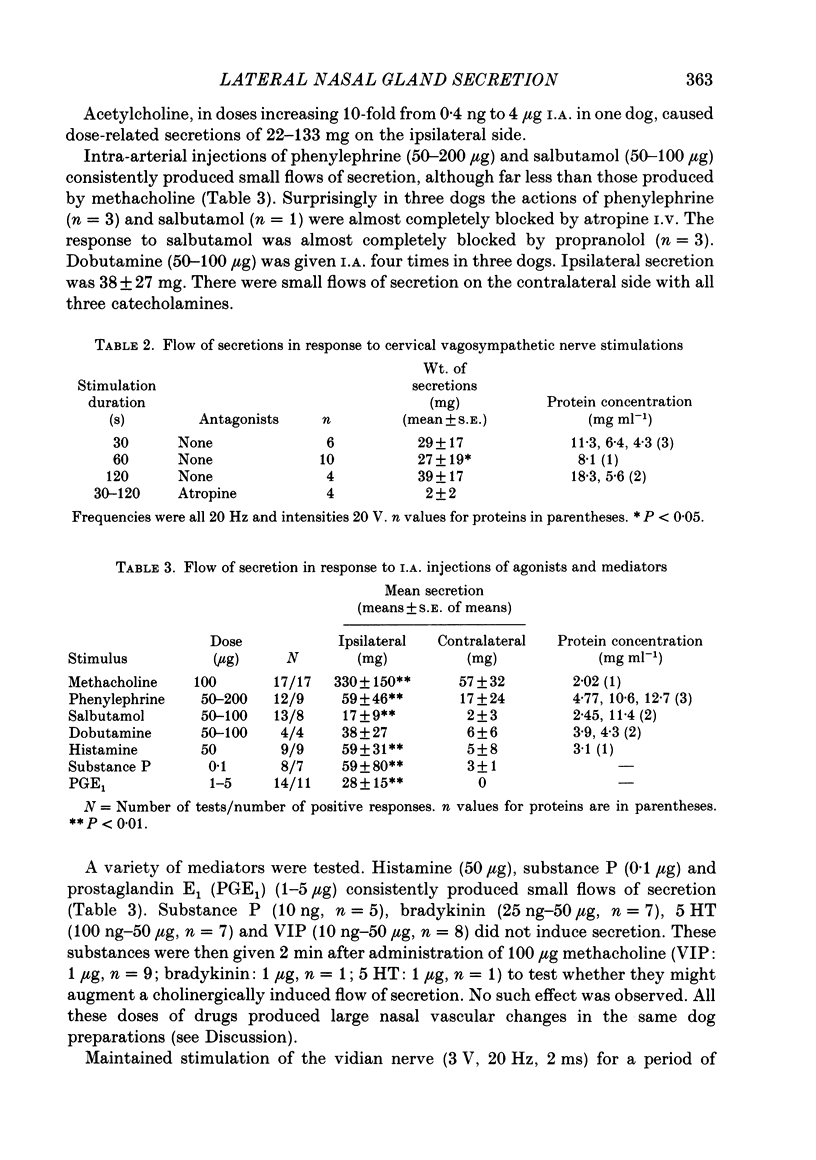
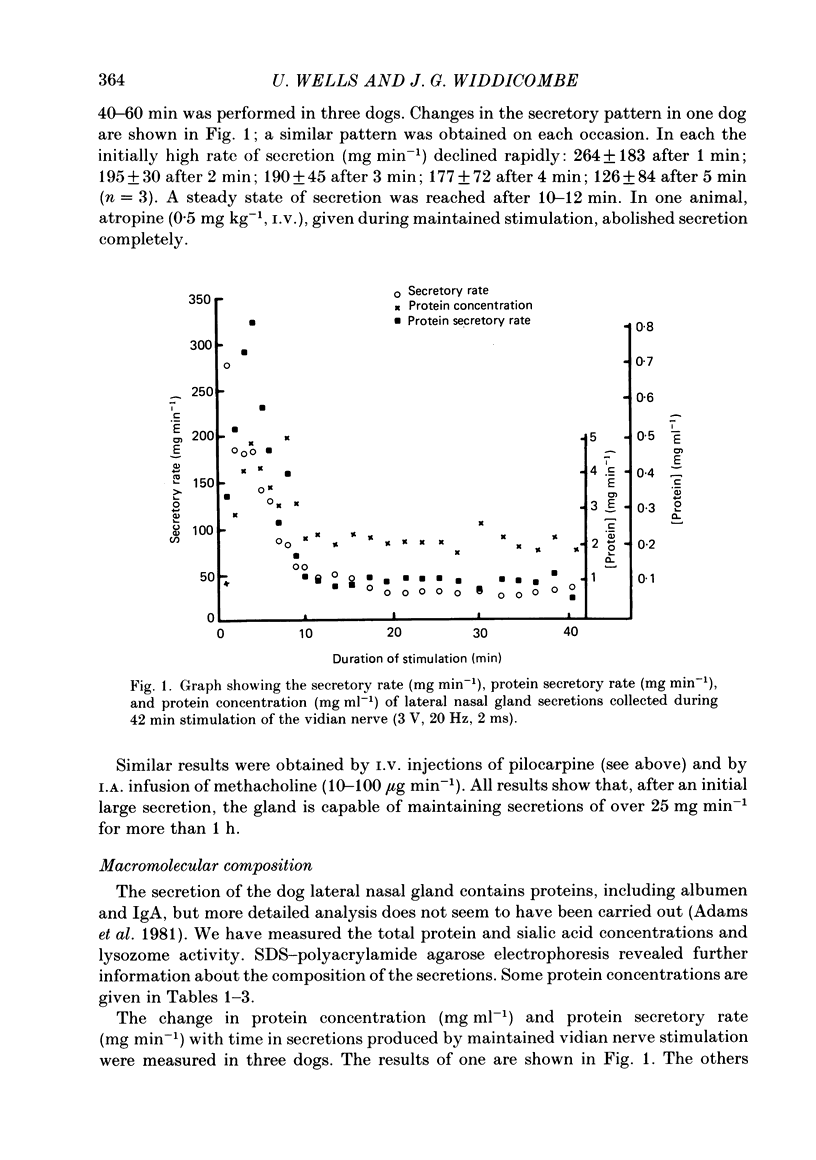
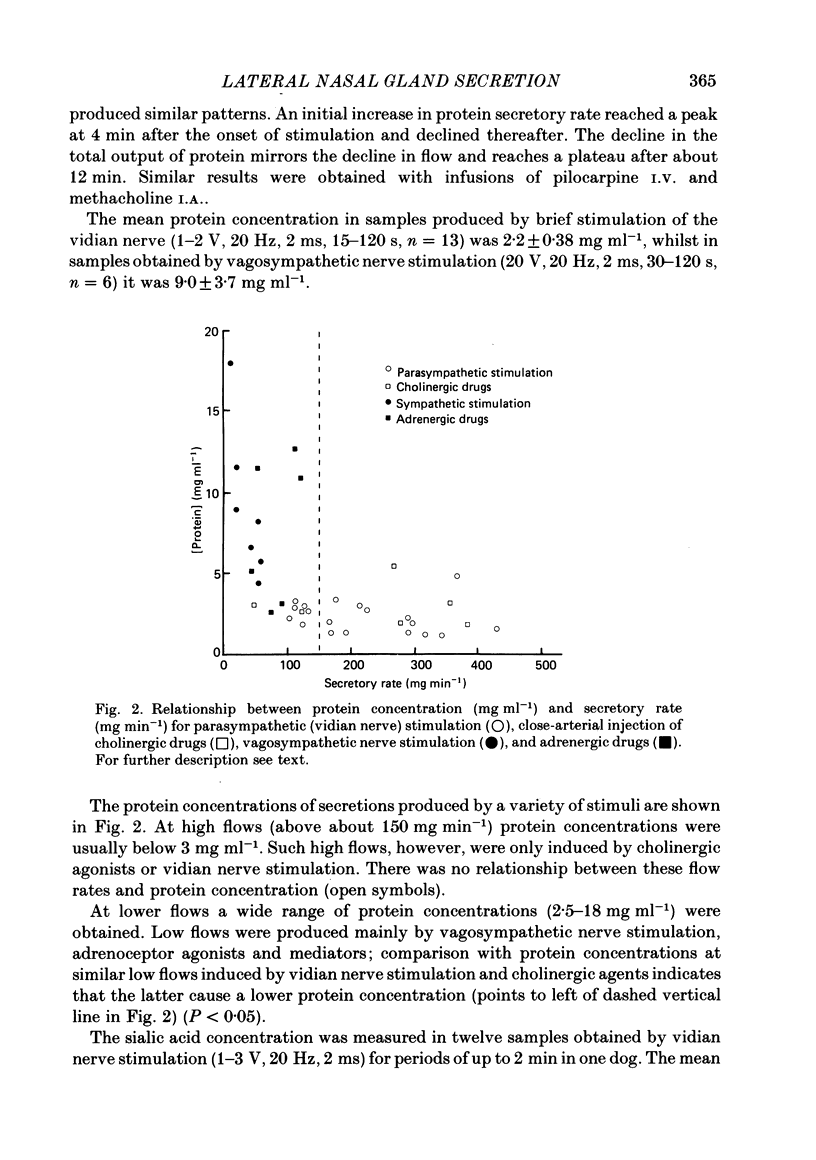
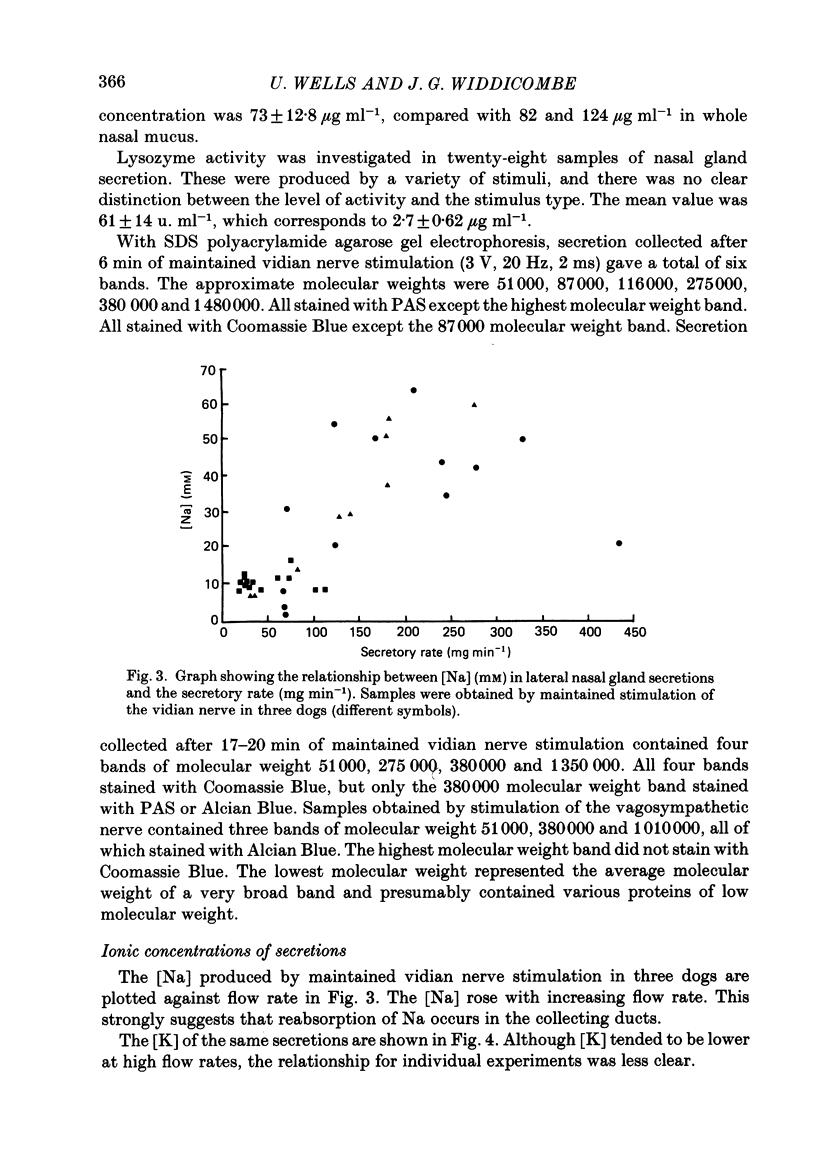
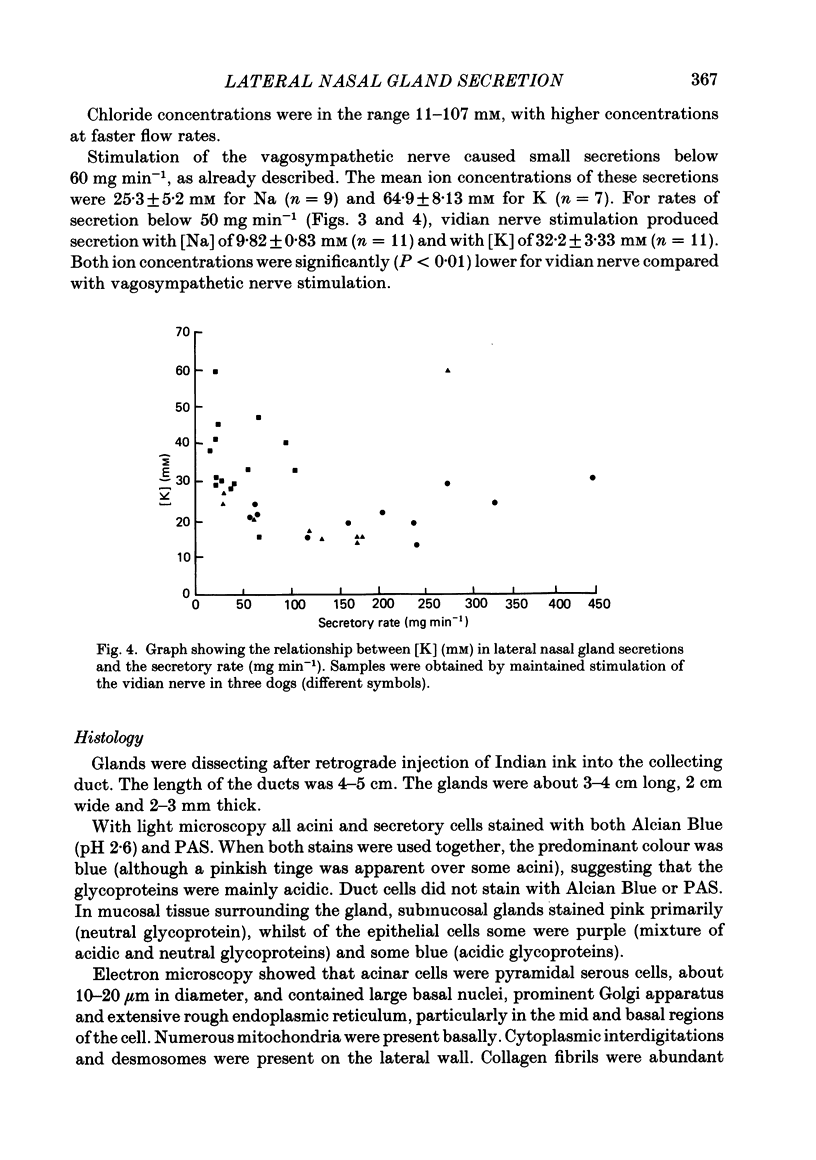
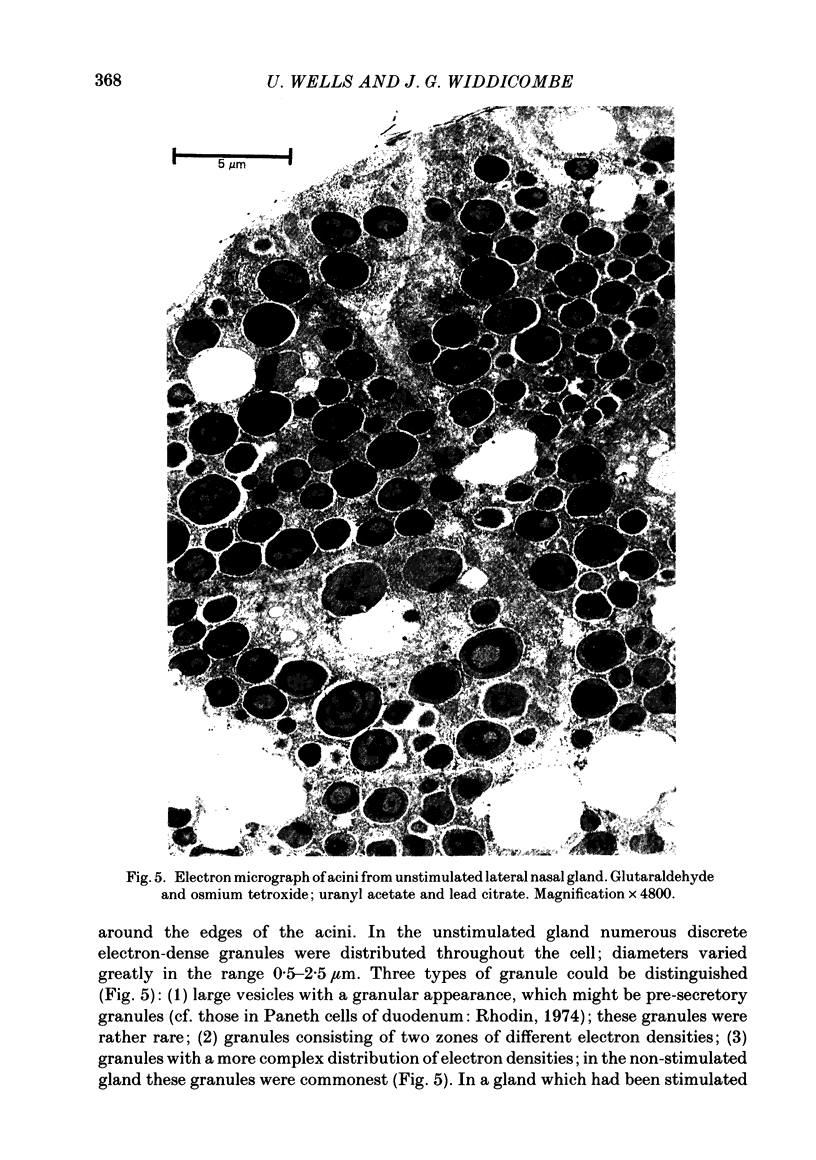
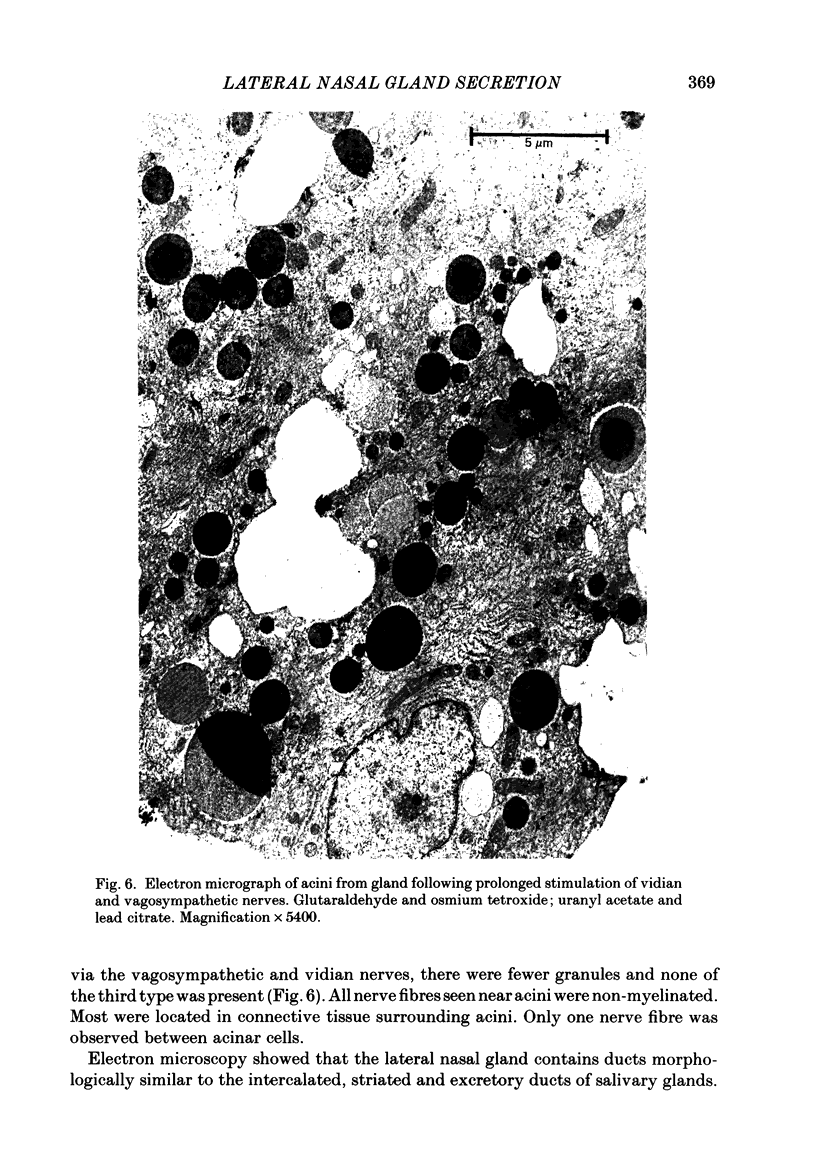

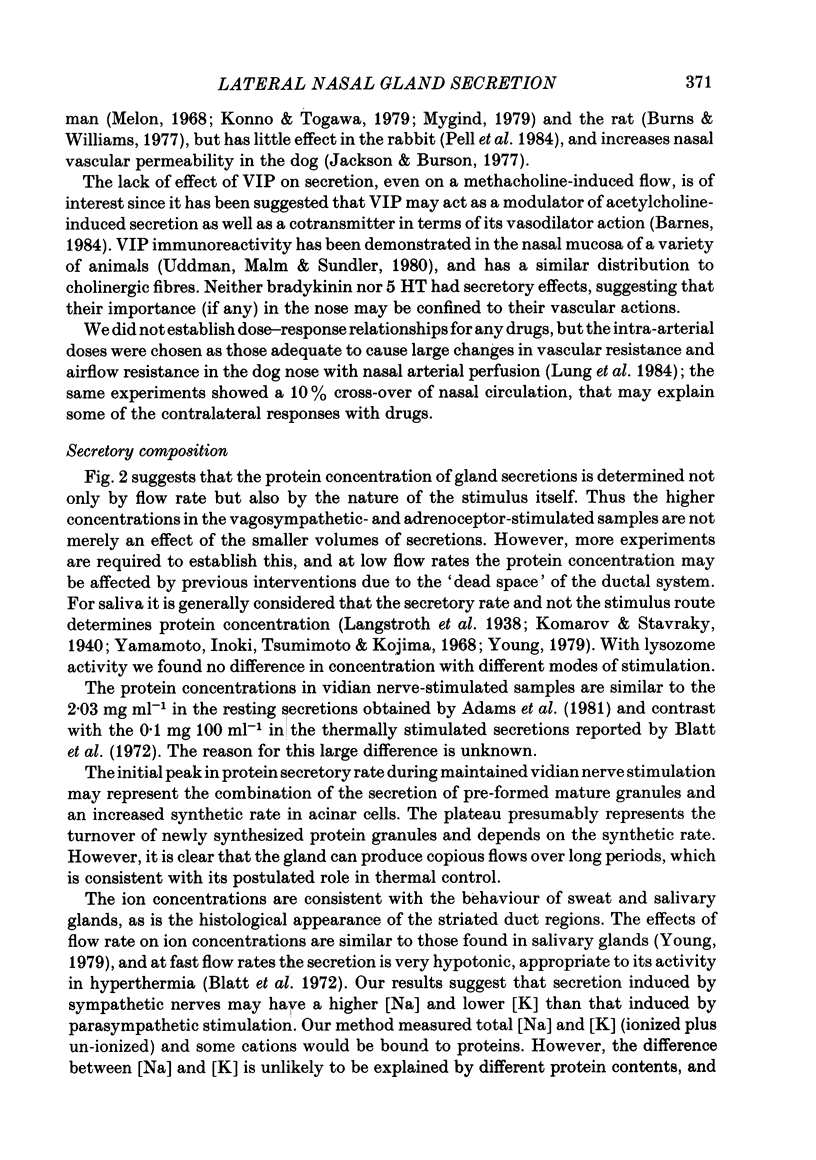
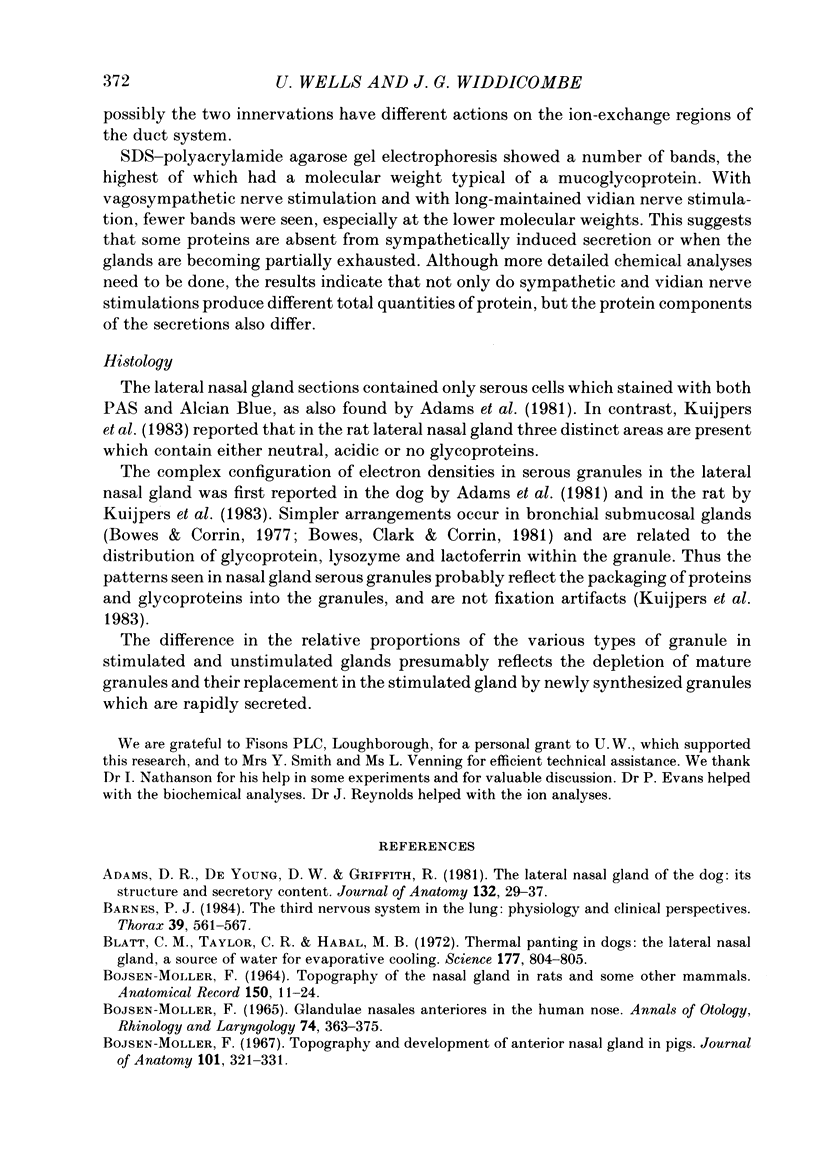
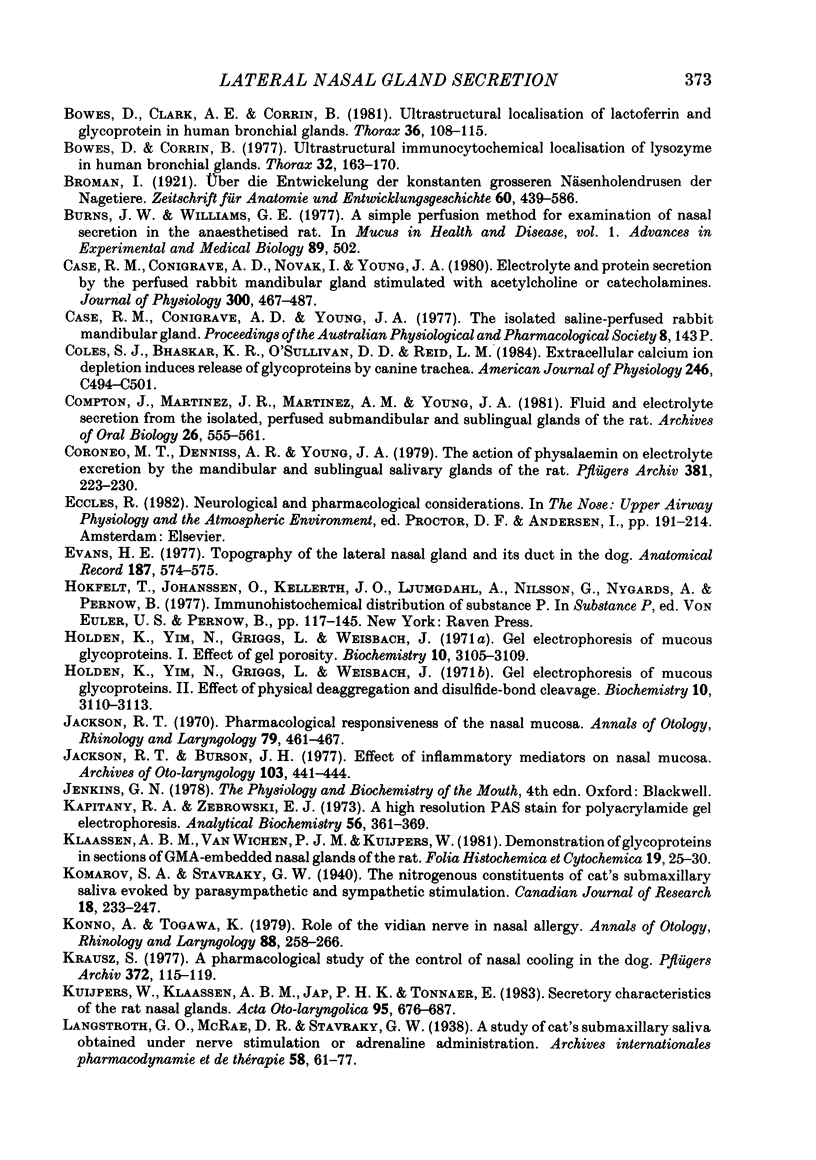
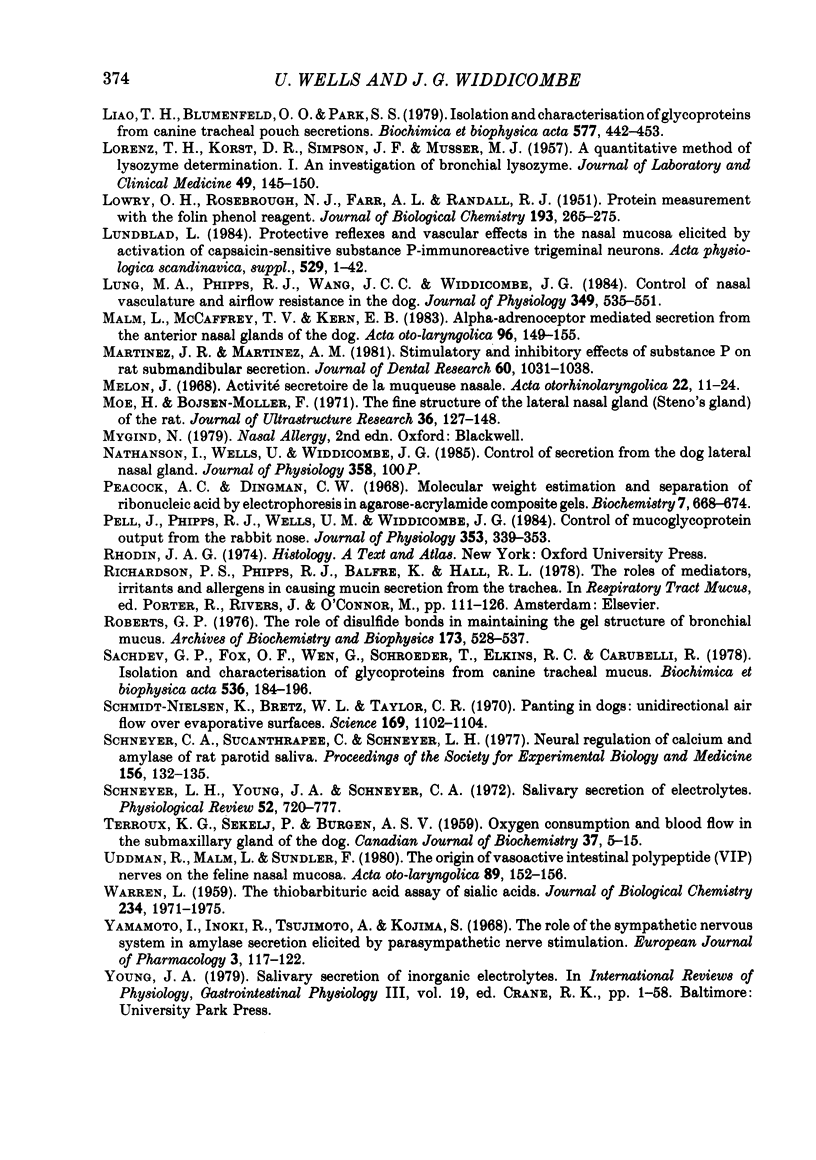
Images in this article
Selected References
These references are in PubMed. This may not be the complete list of references from this article.
- Adams D. R., Deyoung D. W., Griffith R. The lateral nasal gland of dog: its structure and secretory content. J Anat. 1981 Jan;132(Pt 1):29–37. [PMC free article] [PubMed] [Google Scholar]
- BOJSEN-MOLLER F. GLANDULAE NASALES ANTERIORES IN THE HUMAN NOSE. Ann Otol Rhinol Laryngol. 1965 Jun;74:363–375. doi: 10.1177/000348946507400207. [DOI] [PubMed] [Google Scholar]
- BOJSEN-MOLLER F. TOPOGRAPHY OF THE NASAL GLANDS IN RATS AND SOME OTHER MAMMALS. Anat Rec. 1964 Sep;150:11–24. doi: 10.1002/ar.1091500103. [DOI] [PubMed] [Google Scholar]
- Barnes P. J. The third nervous system in the lung: physiology and clinical perspectives. Thorax. 1984 Aug;39(8):561–567. doi: 10.1136/thx.39.8.561. [DOI] [PMC free article] [PubMed] [Google Scholar]
- Blatt C. M., Taylor C. R., Habal M. B. Thermal panting in dogs: the lateral nasal gland, a source of water for evaporative cooling. Science. 1972 Sep 1;177(4051):804–805. doi: 10.1126/science.177.4051.804. [DOI] [PubMed] [Google Scholar]
- Bojsen-Moller F. Topography and development of anterior nasal glands in pigs. J Anat. 1967 Apr;101(Pt 2):321–331. [PMC free article] [PubMed] [Google Scholar]
- Bowes D., Clark A. E., Corrin B. Ultrastructural localisation of lactoferrin and glycoprotein in human bronchial glands. Thorax. 1981 Feb;36(2):108–115. doi: 10.1136/thx.36.2.108. [DOI] [PMC free article] [PubMed] [Google Scholar]
- Bowes D., Corrin B. Ultrastructural immunocytochemical localisation of lysozyme in human bronchial glands. Thorax. 1977 Apr;32(2):163–170. doi: 10.1136/thx.32.2.163. [DOI] [PMC free article] [PubMed] [Google Scholar]
- Case R. M., Conigrave A. D., Novak I., Young J. A. Electrolyte and protein secretion by the perfused rabbit mandibular gland stimulated with acetylcholine or catecholamines. J Physiol. 1980 Mar;300:467–487. doi: 10.1113/jphysiol.1980.sp013173. [DOI] [PMC free article] [PubMed] [Google Scholar]
- Coles S. J., Bhaskar K. R., O'Sullivan D. D., Reid L. M. Extracellular calcium ion depletion induces release of glycoproteins by canine trachea. Am J Physiol. 1984 May;246(5 Pt 1):C494–C501. doi: 10.1152/ajpcell.1984.246.5.C494. [DOI] [PubMed] [Google Scholar]
- Compton J., Martinez J. R., Martinez A. M., Young J. A. Fluid and electrolyte secretion from the isolated, perfused submandibular and sublingual glands of the rat. Arch Oral Biol. 1981;26(7):555–561. doi: 10.1016/0003-9969(81)90017-0. [DOI] [PubMed] [Google Scholar]
- Coroneo M. T., Denniss A. R., Young J. A. The action of physalaemin on electrolyte excretion by the mandibular and sublingual salivary glands of the rat. Pflugers Arch. 1979 Sep;381(3):223–230. doi: 10.1007/BF00583253. [DOI] [PubMed] [Google Scholar]
- Holden K. G., Yim N. C., Griggs L. J., Weisbach J. A. Gel electrophoresis of mucous glycoproteins. I. Effect of gel porosity. Biochemistry. 1971 Aug 3;10(16):3105–3109. doi: 10.1021/bi00792a019. [DOI] [PubMed] [Google Scholar]
- Holden K. G., Yim N. C., Griggs L. J., Weisbach J. A. Gel electrophoresis of mucous glycoproteins. II. Effect of physical deaggregation and disulfide-bond cleavage. Biochemistry. 1971 Aug 3;10(16):3110–3113. doi: 10.1021/bi00792a020. [DOI] [PubMed] [Google Scholar]
- Jackson R. T., Burson J. H. Effect of inflammatory mediators on nasal mucosa. Arch Otolaryngol. 1977 Aug;103(8):441–444. doi: 10.1001/archotol.1977.00780250035001. [DOI] [PubMed] [Google Scholar]
- Jackson R. T. Pharmacological responsiveness of the nasal mucosa. Ann Otol Rhinol Laryngol. 1970 Jun;79(3):461–467. doi: 10.1177/000348947007900305. [DOI] [PubMed] [Google Scholar]
- KORST D. R., LORENZ T. H., MUSSER M. J., SIMPSON J. F. A quantitative method of lysozyme determination. I. An investigation of bronchial lysozyme. J Lab Clin Med. 1957 Jan;49(1):145–150. [PubMed] [Google Scholar]
- Kapitany R. A., Zebrowski E. J. A high resolution PAS stain for polyacrylamide gel electrophoresis. Anal Biochem. 1973 Dec;56(2):361–369. doi: 10.1016/0003-2697(73)90202-9. [DOI] [PubMed] [Google Scholar]
- Konno A., Togawa K. Role of the vidian nerve in nasal allergy. Ann Otol Rhinol Laryngol. 1979 Mar-Apr;88(2 Pt 1):258–266. doi: 10.1177/000348947908800219. [DOI] [PubMed] [Google Scholar]
- Krausz S. A pharmacological study of the control of nasal cooling in the dog. Pflugers Arch. 1977 Dec 12;372(2):115–119. doi: 10.1007/BF00585324. [DOI] [PubMed] [Google Scholar]
- Kuijpers W., Klaassen A. B., Jap P. H., Tonnaer E. Secretory characteristics of the rat nasal glands. Acta Otolaryngol. 1983 May-Jun;95(5-6):676–687. doi: 10.3109/00016488309139462. [DOI] [PubMed] [Google Scholar]
- LOWRY O. H., ROSEBROUGH N. J., FARR A. L., RANDALL R. J. Protein measurement with the Folin phenol reagent. J Biol Chem. 1951 Nov;193(1):265–275. [PubMed] [Google Scholar]
- Liao T. H., Blumenfeld O. O., Park S. S. Isolation and characterization of glycoproteins from canine tracheal pouch secretions. Biochim Biophys Acta. 1979 Apr 25;577(2):442–453. doi: 10.1016/0005-2795(79)90048-5. [DOI] [PubMed] [Google Scholar]
- Lundblad L. Protective reflexes and vascular effects in the nasal mucosa elicited by activation of capsaicin-sensitive substance P-immunoreactive trigeminal neurons. Acta Physiol Scand Suppl. 1984;529:1–42. [PubMed] [Google Scholar]
- Lung M. A., Phipps R. J., Wang J. C., Widdicombe J. G. Control of nasal vasculature and airflow resistance in the dog. J Physiol. 1984 Apr;349:535–551. doi: 10.1113/jphysiol.1984.sp015172. [DOI] [PMC free article] [PubMed] [Google Scholar]
- Malm L., McCaffrey T. V., Kern E. B. alpha-Adrenoceptor-mediated secretion from the anterior nasal glands of the dog. Acta Otolaryngol. 1983 Jul-Aug;96(1-2):149–155. doi: 10.3109/00016488309132885. [DOI] [PubMed] [Google Scholar]
- Martinez J. R., Martinez A. M. Stimulatory and inhibitory effects of substance P on rat submandibular secretion. J Dent Res. 1981 Jun;60(6):1031–1038. doi: 10.1177/00220345810600060501. [DOI] [PubMed] [Google Scholar]
- Moe H., Bojsen-Moller F. The fine structure of the lateral nasal gland (Steno's gland) of the rat. J Ultrastruct Res. 1971 Jul;36(1):127–148. doi: 10.1016/s0022-5320(71)80093-x. [DOI] [PubMed] [Google Scholar]
- Peacock A. C., Dingman C. W. Molecular weight estimation and separation of ribonucleic acid by electrophoresis in agarose-acrylamide composite gels. Biochemistry. 1968 Feb;7(2):668–674. doi: 10.1021/bi00842a023. [DOI] [PubMed] [Google Scholar]
- Pell J., Phipps R. J., Wells U. M., Widdicombe J. G. Control of mucoglycoprotein output from the rabbit nose. J Physiol. 1984 Aug;353:339–353. doi: 10.1113/jphysiol.1984.sp015339. [DOI] [PMC free article] [PubMed] [Google Scholar]
- Richardson P. S., Phipps R. J., Balfre K., Hall R. L. The roles of mediators, irritants and allergens in causing mucin secretion from the trachea. Ciba Found Symp. 1978;(54):111–131. doi: 10.1002/9780470720356.ch6. [DOI] [PubMed] [Google Scholar]
- Roberts G. P. The role of disulfide bonds in maintaining the gel structure of bronchial mucus. Arch Biochem Biophys. 1976 Apr;173(2):528–537. doi: 10.1016/0003-9861(76)90289-7. [DOI] [PubMed] [Google Scholar]
- Sachdev G. P., Fox O. F., Wen G., Schroeder T., Elkins R. C., Carubelli R. Isolation and characterization of glycoproteins from canine tracheal mucus. Biochim Biophys Acta. 1978 Sep 26;536(1):184–196. doi: 10.1016/0005-2795(78)90064-8. [DOI] [PubMed] [Google Scholar]
- Schmidt-Nielsen K., Bretz W. L., Taylor C. R. Panting in dogs: unidirectional air flow over evaporative surfaces. Science. 1970 Sep 11;169(3950):1102–1104. doi: 10.1126/science.169.3950.1102. [DOI] [PubMed] [Google Scholar]
- Schneyer C. A., Sucanthapree C., Schneyer L. H. Neural regulation of calcium and amylase of rat parotid saliva (39891). Proc Soc Exp Biol Med. 1977 Oct;156(1):132–135. doi: 10.3181/00379727-156-39891. [DOI] [PubMed] [Google Scholar]
- Schneyer L. H., Young J. A., Schneyer C. A. Salivary secretion of electrolytes. Physiol Rev. 1972 Jul;52(3):720–777. doi: 10.1152/physrev.1972.52.3.720. [DOI] [PubMed] [Google Scholar]
- TERROUX K. G., SEKELJ P., BURGEN A. S. Oxygen consumption and blood flow in the submaxillary gland of the dog. Can J Biochem Physiol. 1959 Jan;37(1):5–15. [PubMed] [Google Scholar]
- Uddman R., Malm L., Sundler F. The origin of vasoactive intestinal polypeptide (VIP) nerves in the feline nasal mucosa. Acta Otolaryngol. 1980 Jan-Feb;89(1-2):152–156. doi: 10.3109/00016488009127121. [DOI] [PubMed] [Google Scholar]
- WARREN L. The thiobarbituric acid assay of sialic acids. J Biol Chem. 1959 Aug;234(8):1971–1975. [PubMed] [Google Scholar]
- Yamamoto I., Inoki R., Tsujimoto A., Kojima S. The role of the sympathetic nervous system in amylase secretion elicited by parasympathetic nerve stimulation. Eur J Pharmacol. 1968 May;3(2):117–122. doi: 10.1016/0014-2999(68)90062-9. [DOI] [PubMed] [Google Scholar]
- Young J. A. Salivary secretion of inorganic electrolytes. Int Rev Physiol. 1979;19:1–58. [PubMed] [Google Scholar]



